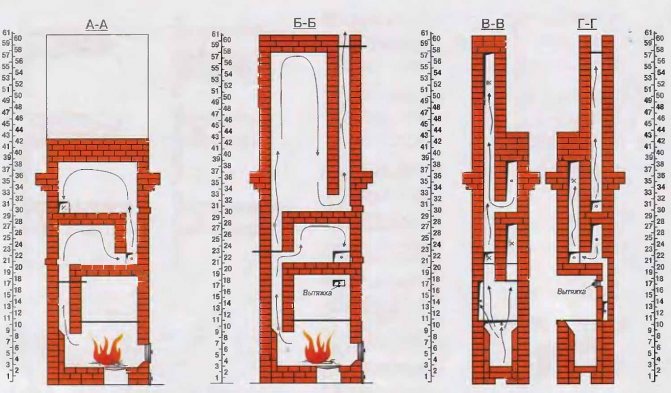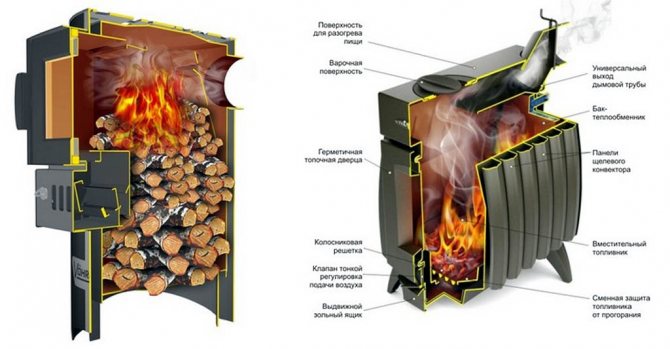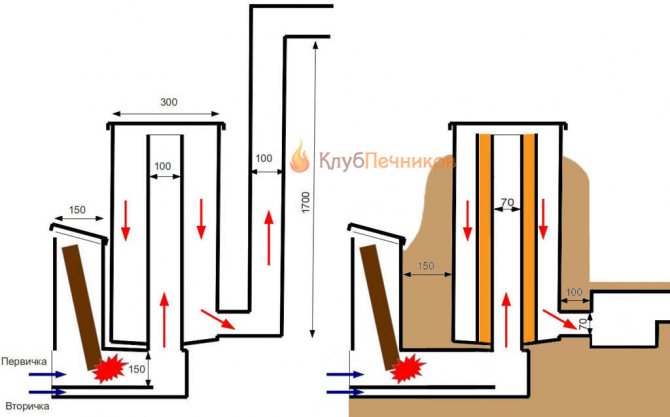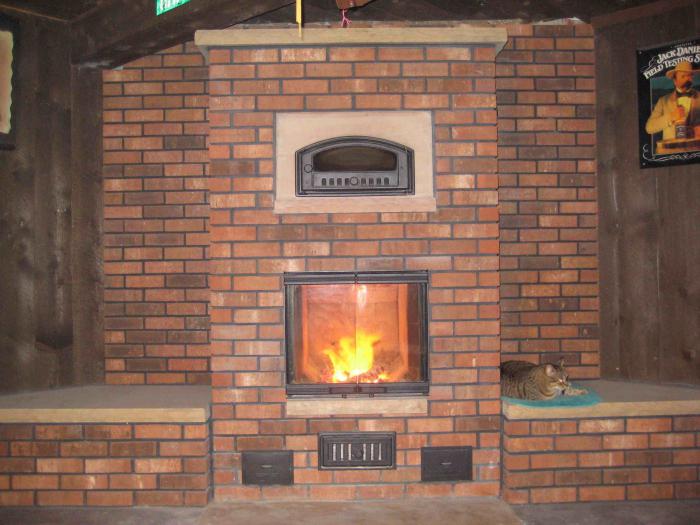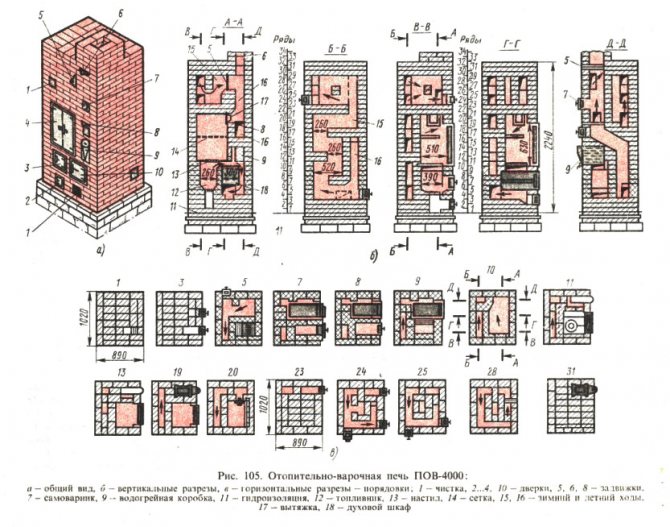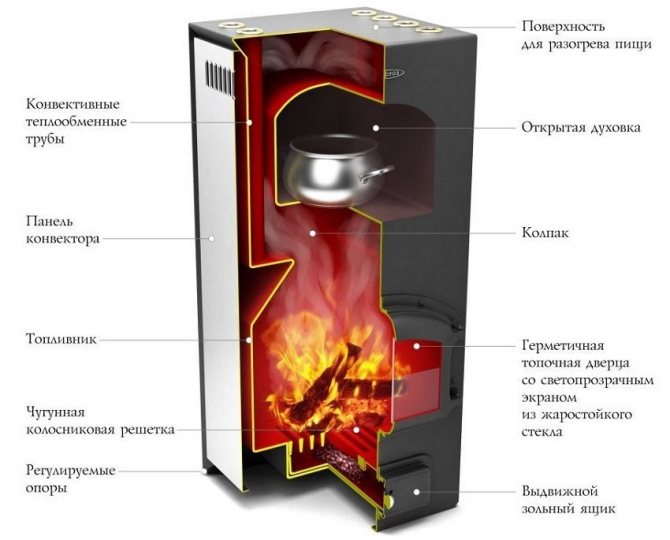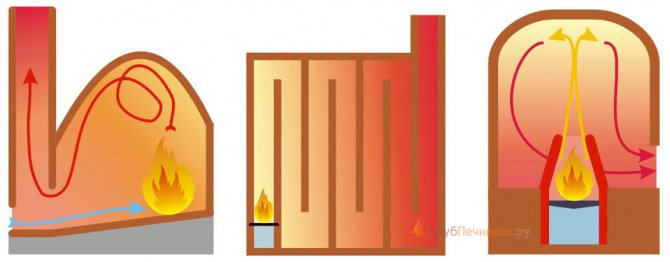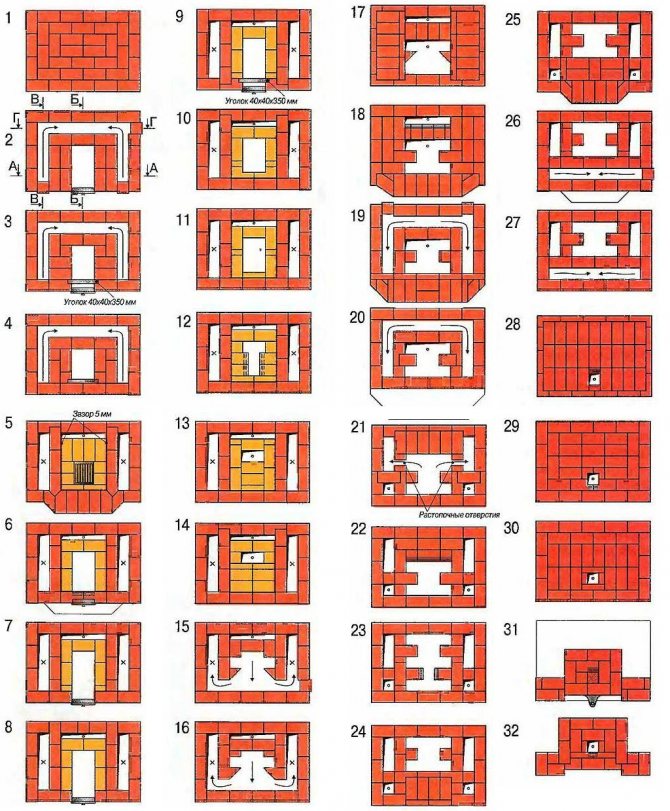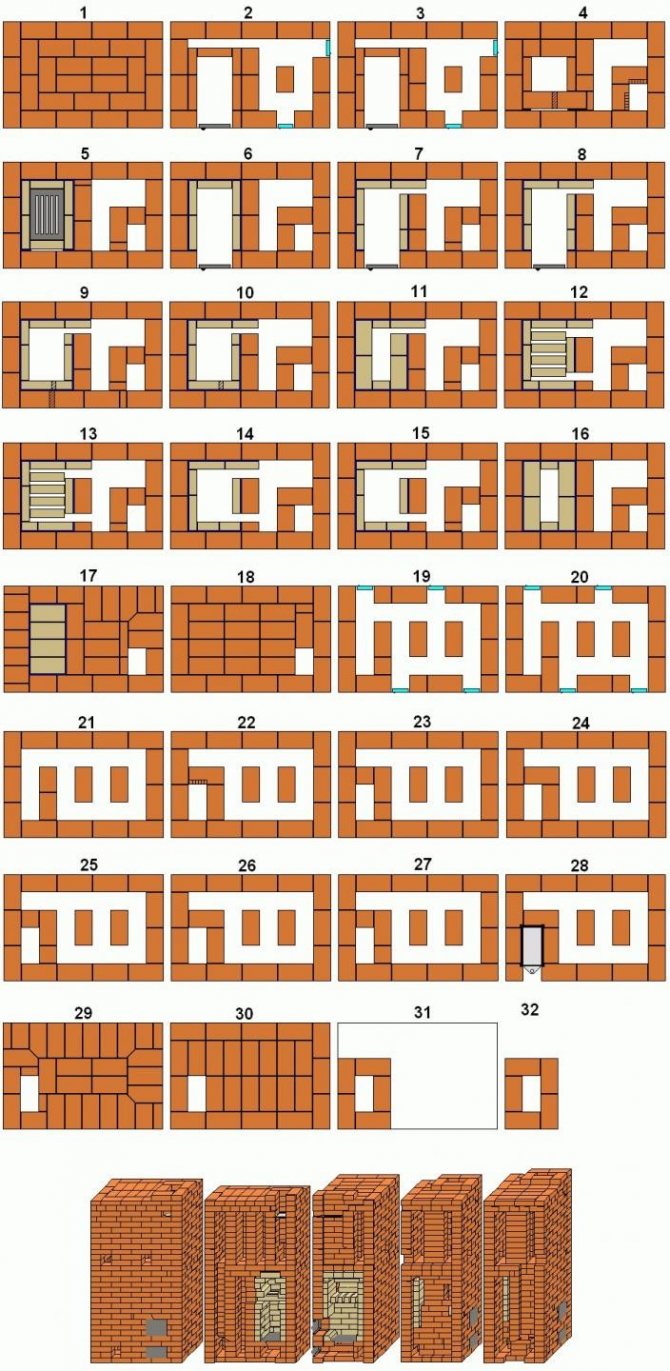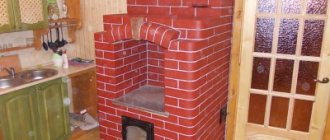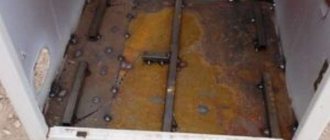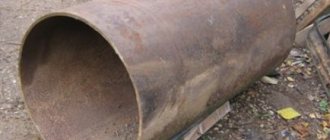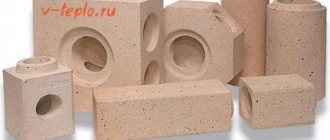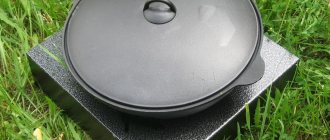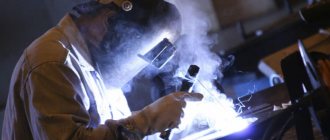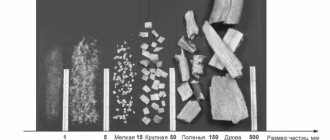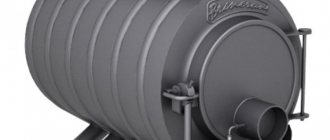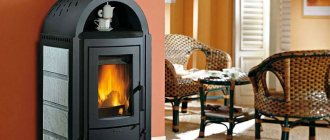Operating principle of ovens with two bells
The secret of the efficiency of this stove lies in its original design, which allows accumulating and storing heat for a long time. To understand the principle of operation of a two-bell furnace, consider its structural diagram.
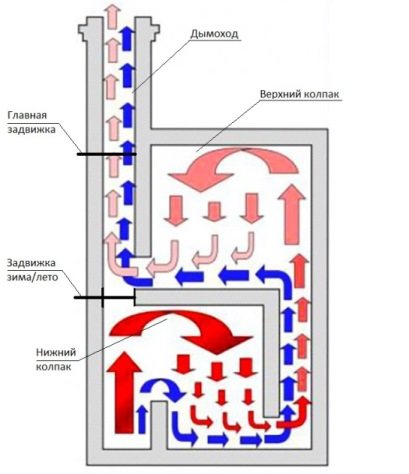
After firing up in winter, the incandescent flue gases rise under the roof of the lower bell, transferring heat to the surrounding walls and the hob. But new air enters the combustion chamber, the combustion process continues and the release of hot combustion products continues, displacing the cooled gases under the top of the bell. Those, in turn, descend and fall into a vertical channel leading to the upper bell, where the two-bell design of the furnace provides for the repetition of the previous process with the release of gases to the outside through the chimney.
The temperature of the flue gases coming out is lower than any other stove with a stove, as they intensively give off their heat to the walls of the stove. For this reason, the chimneys of heat sources of this design must be protected from the destructive effects of condensation. After heating is over, heat remains for a long time at the top of both hoods, even if the main valve remains open. Cold air entering through the blower cannot rise under the dome of the hood and passes into the chimney along the path indicated in the diagram by blue arrows.
A two-bell hob oven with a stove allows you to cook food in the summer thanks to an additional valve, the opening of which passes gases directly into the chimney. If the valve is not fully opened, then the flow of combustion products is divided into two, going along different paths. In this way, in the autumn-spring period, it is possible to regulate the intensity of warming up the hoods, that is, the heat output of the stove.
Operating principle
Such heating is effective for rooms with a total area up to 60 m2, therefore, the design of the furnace itself is compact, does not require a high chimney and operates according to the "automatic view" scheme.
Gases in such a chimney move according to the laws of natural convection, freely and not limited to the walls of the channels and valves. In this case, an unheated air stream simply flows around the hot air, and does not blow it out of the oven.
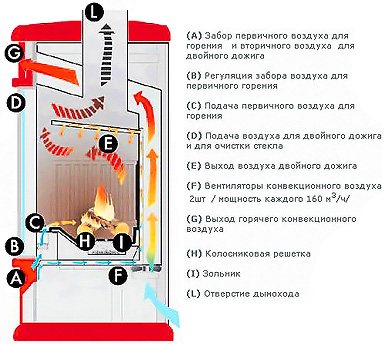

Furnace operation diagram
The heat output of a given stove depends on the type of construction and the type of fuel used.
As an example, consider a stove with an outer wall in a half-brick with a hot water box, an oven and a cast-iron hob for two burners.
- To increase heat transfer, the firebox is covered with a cast-iron stove. Heat transfer depends on the thickness of the slab, so it is advisable to take the slab as thick as possible. Above it is equipped with a cooking chamber in a niche with steel doors. The oven is located on the side of the firebox;
- Installation of a heating and cooking oven is carried out with the expectation of a double mode of operation: summer and winter. When operating in summer mode, the stove is used as a cooker. During operation, hot gas goes under the hob, oven, and then into the chimney;
- In winter operation, hot gas passes through the stove and oven, and then enters the upper chamber through the heating channels, heating the room, and only then is removed into the chimney.
Kuznetsov furnaces device and principles of operation, advantages, variations, drawings
Kuznetsov's stoves are well known not only to stove-makers - they heat many houses in Russia and abroad. I. V.Kuznetsov has been working on improving the furnaces since 1962 and has gathered a strong team of like-minded people around him. The team has more than 150 developments covering almost the entire range of household stoves, see fig.
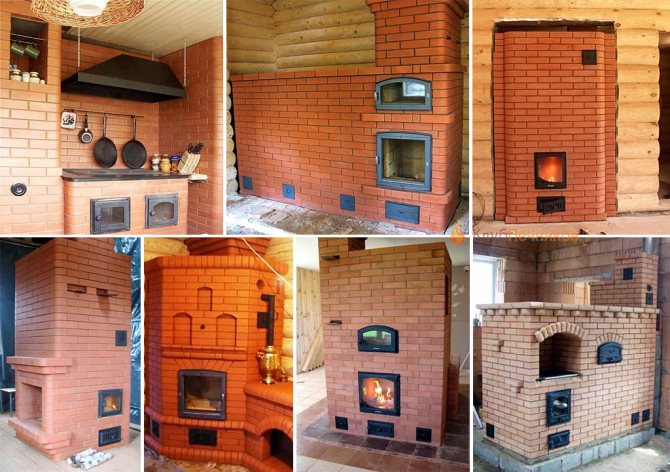

Some of the stoves I. V. Kuznetsov
Many would like to fold some of Kuznetsov's stoves with their own hands, and this article is to help them. But we are not going to reveal some hidden secrets of "blacksmiths" - they simply do not exist. On the website of Igor Viktorovich stove.ru, those who wish will find a huge array of stove information for free: from information on the design and construction of stoves to detailed drawings and recommendations for installing a stove in a house and arranging a blind area around a building with stove heating. We also do not intend to criticize or correct anything in this home-stove encyclopedia: we are far from IV Kuznetsov in stove business, to put it mildly, far away.
The purpose of this article is to provide a kind of introduction to the body of Kuznetsov's information, which allows one to more freely navigate in the source material. Let us explain with an example why this is needed.
Let's say I'm a station wagon mechanic with a lot of experience and I want to pass it on to others interested. A car is a complicated thing. If I start to get distracted along the way, explaining in detail that how the run-in and caster (let's say, readers are not really teapots, now everyone drives) affect the handling and directional stability of the car, and the gas distribution diagram affects fuel consumption depending on the road conditions, and so on, I will eventually get confused to the point that I myself no longer understand how the car I drive works. Willy-nilly, I will have to present the material, albeit "on the fingers", but in a professional manner fluently.
However, it will be difficult to read it, even for specialists like me, and an amateur will generally be dizzy. Therefore, I need someone to help me, who can be conditionally called a "recipient". In fact, he is not a kettle at all, he can adjust the suspension himself and set the valve tappets. But in this case, his task is to describe how the entire filling of the car is assembled into a single whole, controlled according to the principle: "Steer the wheel, gas the gas, brake with the brake."
In the automotive industry of the USSR, a similar situation arose in the late 50s - early 60s, when the industry began to produce cars for widespread sale to the population. Then the superbstseller of that time was published - "How the car works". Edited by none other than the chief designer of the legendary "Victory" A. Lipgart.
The information "from the recipient" will not yet allow you to get down to work: it does not provide deep knowledge that will allow you to at least intuitively figure out the necessary values of the numerical parameters along the way. But it is fundamentally fundamental: owning it, a professional text is read with understanding and faster. And, if somewhere something in him is still incomprehensible, this no longer causes loss and rushing, but just a mark in the mind: you need to find out more about this.
So far, the government has not adopted any landmark decisions on stoves and stove heating. But their role in household heat power engineering in times of energy shortages is undeniable: a heating stove with an efficiency of 70%, when used massively, will save fuel on a national scale, because in the projects of new heating plants, heat losses in the mains of 35% are included, and it is not yet possible to reduce them. So with the popularization of stove knowledge, you have to get out yourself, without being neither Lipgart nor Kuznetsov. Well, let's try.
Design and principle of operation
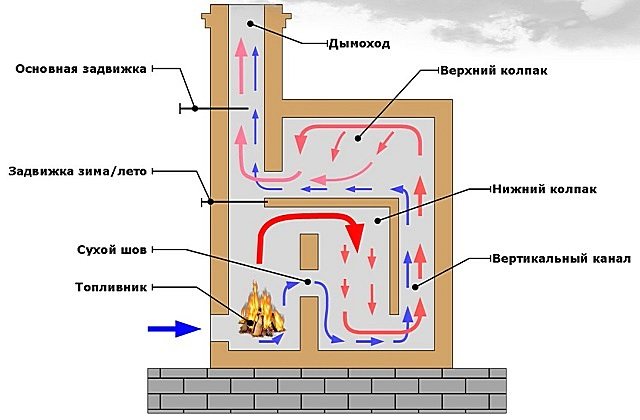

Bell furnace design
The stove with a hood was developed by engineer Igor Kuznetsov in the early 60s of the last century.Subsequently, the Russian metallurgist Leonid Kotlyar improved the design so that it retains heat up to 19 hours. The peculiarity of "blacksmithing" is that the heated air does not leave the pipe, but is collected under the hood. It gradually cools down and is displaced by rising hot streams. The advantageous difference between a bell-type stove used for heating a house and a duct stove, where hot air under the influence of draft, freely goes out into the street, lies in saving heat.
A two-meter-high structure with a base of 1m * 1m can reach a heat output of 3.5–4.5 kW. Such a bell-type stove is enough to heat a house of 50 square meters in a temperate climatic zone, if you heat it twice a day.
The inventor has improved the design by adding another hood. In Kuznetsov's two-bell heating furnace, the first covering element is connected to the combustion chamber and separates the cold and heated streams. The second bell is located in the upper part of the stove, trapping hot air, which, before entering the chimney, gives off heat to the bricks for a long time.
A two-bell oven is more economical in fuel consumption and is usually equipped with a hob. This allows you to prepare delicious meals without consuming electricity or gas. The design of the stove already includes an extractor hood - there is no need to install an additional ventilation system.
Home option
Iron bell-type stoves are not suitable for heating a house. In the house, such a stove must be made of bricks. Newbie do it yourself do not fold the bell-top oven. Her ordering is very complicated. Because of this, it is best to entrust such work to the masters who will put together the "blacksmithing" of the desired configuration according to the prepared drawings. In addition, the master himself can prepare the necessary drawing.
Do not think that modern heating devices greatly bypass brick stoves in their characteristics. Perhaps they are more efficient in terms of heat transfer, but in terms of functionality they are inferior to “blacksmiths”.
Today bell-type stoves for home are not much like their predecessors: "Swedes" and "Dutch". They use a different method of using hot gases.
Feature of the new ovens, which are popularly called "blacksmiths", is that heated gases circulate in them under their own weight. They do not need chimneys through which heat loss occurs. Heat in "blacksmiths" is collected under the dome of the hood. Naturally, the gas gradually cools, releasing heat into the surrounding environment, and slowly descends, where it collides with the hotter gas rising up. Because of this, cold air is forced out from under the hood by hot gases.
Diagram of the construction of a Kuznetsov furnace with your own hands
If in a traditional stove gas is drawn out through the chimney, then in a blacksmithing room it is pushed out. Moreover, the cap itself can be used for domestic needs. This can be a cooking platform, a dryer, a container for heating water, etc. That is home owners receive a dual-use design.
According to their functional characteristics, "Kuznetsovki" are divided into the following types:
- Bathhouse.
- For cooking food.
- Fireplaces.
- Heating.
- Combined.
In Russia, preference is given to combined brick solutions. They can cook food, and at the same time they provide a long burning fuel and efficient heating of the house.
More about plump
In theory, round stoves generally have a lot of advantages, only they are not very convenient in the house. However, there is a considerable demand for compact mobile furnaces, and here the extremely high efficiency of round multi-caps can be a decisive factor, because when the size of the furnace decreases, its efficiency drops sharply due to the square-cube law.
Such ovens, of course, would have to be made of metal. This solves the problem of cleaning, the stove can be made collapsible.But the choice of metals suitable for the ratio of heat capacity and thermal conductivity is extremely limited. Of the inexpensive - only cast iron, but it is heavy and fragile.
However, there is a lighter and stronger metal material with similar properties. These are products of powder metallurgy. When applied to scissor knives, "powder rubbish" is quite justified, but for a furnace in which nothing works for shear, powder parts can be a godsend.
The second problem, which has already been mentioned, is the heat-resistant lining on the roof of the first bell. If it is possible to solve it, then, perhaps, the works and efforts of Igor Viktorovich Kuznetsov will bear fruit more extensive and significant than it seems now.
Second heat load
Nothing works on bare principles. In order for a theoretically absolutely correct stove to heat, dry and cook well, it must also be performed correctly in the material. With regard to bell-type furnaces (and especially to two-bell ones), this means that the thermal load on the material must be high. To make a massive bell-type stove with thick walls is like making a fire in a cave. To feel the warmth, you need to sit by the fire itself, and there will be soot ...
Take a look at fig. On it - drawings and orders of some of Kuznetsov's stoves: a bathhouse. heating and cooking. a double-circuit hot water boiler and an improved Russian with a stove bench. Not being an experienced stove-maker, it is clear that the amount of material per unit of released power (500 W * sq. M of the outer surface) in the Kuznetsov furnace is one and a half to two times less than in the traditional ones. In general, any bell-type furnace is "empty" inside a channel furnace of equal power.
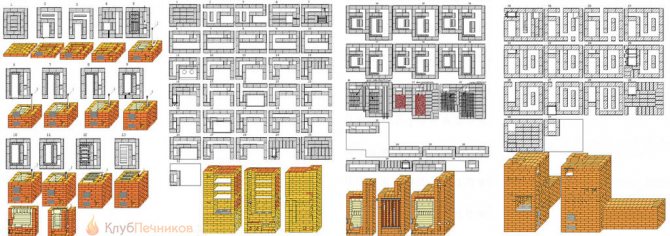

The orders of some Kuznetsov furnaces
On the one hand, this is good, a brick with a masonry mortar costs money. But on the other hand, it requires careful development and adherence to the construction technology (see below). The heat load, from which the pile of cobblestone does not move, will destroy the thin brick wall already during the accelerating firebox.
For Kuznetsov furnaces, structural mechanics are also important. The strength of the wall on clay mortar decreases with decreasing its thickness much faster than on cement-sand. Therefore, the foundation for these furnaces must be carried out especially carefully in strict accordance with the recommendations of the author. They also need to be strictly followed during construction.
Note: I. V. Kuznetsov allows you to freely copy your materials for yourself, for construction, but objects to reprints. However, the pictures in Fig. small. A dilettante will not build anything on them, but a master knows where to get full-fledged drawings. Therefore, we hope that Igor Viktorovich will forgive us for this small borrowing for the good of the cause.
Two-bell furnaces Kuznetsova order and its features
The principle of building furnaces in which it is possible to realize the law of free movement of gases has been known for a relatively long time. The most common and well-known option is a two-melt furnace.
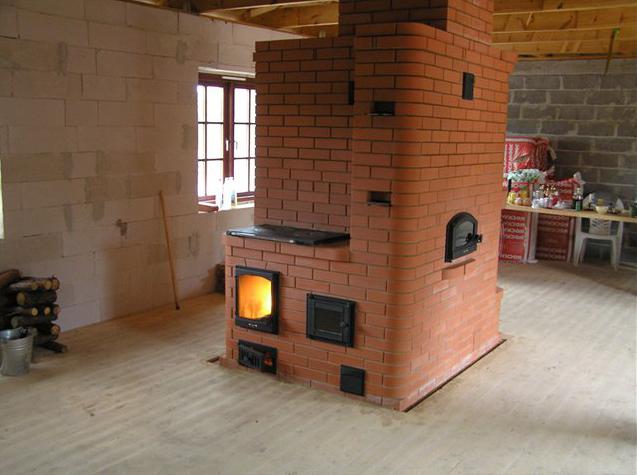

The principle of its operation is that air from the environment enters the furnace through the blower. At the first stage of combustion, when the lightest fuel fractions are burned, the process is somewhat reminiscent of pyrolysis. This mode is the most effective. But before Kuznetsov, few people enjoyed these advantages. But the orders have a design that allows them to work in a pyrolysis mode. As a result, pyrolysis gases burn under the dome of the third bell. The process itself is interesting. Its peculiarity is that the combustion is self-regulating. If the flame spreads too much, then the draft deteriorates, and the combustion process slows down, if the heat is not enough, the draft increases, and the combustion process intensifies. Kuznetsov's two-bell furnaces (ordering) have a second dome so that the combustion process is not disturbed.The temperature in the second bell with an efficiency of about 80% reaches 300-400 degrees, and this is quite enough to transfer heat to the coolant.
The main stages of arranging a brick oven in order with your own hands
When using ordering for heating and cooking ovens, a number of key steps must be performed. All of them have their own nuances of conducting and unique characteristics, knowing which you can ensure a high level of quality and minimize the cost of arranging a furnace with your own hands.
Next, an example of a furnace arrangement based on the Swedish order will be considered.
Work technology
In the design of a similar heating system. already in order, a blower is provided. This is especially necessary to remember when starting work on arranging the furnace with your own hands.
At the same time, it is important to take into account the peculiarities of laying the 1st row of bricks The fact is that here it is necessary to ensure compliance with the level and control of the corners, using a construction square for this purpose;
At the same time, it is necessary to pay attention to all the characteristics of the first row. The fact is that this largely affects not only the service life and reliability of the heating installation, but also the efficiency of its operation;
The technology of using the ordering provides, upon completion of the laying of the first furnace row, the installation of the door and the blower, after which they begin to lay the 2nd row;
When erecting the 3rd row of the cooking oven, it is necessary to adhere exactly to the ordering instructions.To create a blower, bricks should be chopped off on each side
And here it is necessary to take into account that the row being arranged must have the same height as the door;
For laying the 4th row of stove masonry, choose a place on the left side. This work begins with the installation of a door to ensure ash removal. This will prevent normal operation of the machine. As for the masonry itself, when it is performed, they adhere to the same order as in the scheme itself. Moreover, it is imperative to take care of overlapping the blower door. A square hole must be made above the ash pan. This idea is realized by laying bricks in a special way;
Starting to lay the 5th row, you need to follow that. so that the opening of the ash pan begins to narrow. In appearance, this row is similar to the 4th one. Therefore, the technology of its laying will be the same;
When starting the device of the 6th row, it is necessary to use a special brick with refractory properties as a material. Most often, a diagram developed by qualified stove-makers contains a note about this in the form of shading. Such a hint allows you to simplify the masonry process and avoid possible difficulties when performing these works;
The brick that will be laid in front of the grate must be chipped off. A detailed solution has a positive effect on the efficiency and quality of the placement of fuel on the grate during use of the stove. At the same time, the 5th row of the oven masonry will directly support the grate;
Bricks of the 6th row and the grate grate should create between themselves a sufficient space 10-15 cm wide, where sand or ash must be placed, and the presence of such a gap is necessary to create the effect of expansion of the grate metal when using a heating device;
After creating the U-shaped channel at the previous stages, it must be closed. Moreover, this is done with the expectation that as a result, three new ones arise. This stage provides for the installation of the furnace door, the support for which will be provided directly by the 6th row of the furnace masonry;
The process of laying the 8th and 9th rows of the Swedish stove masonry is carried out in the same way as in the case of the 7th.In this case, it must be remembered that it must have the same placement height as the door of the combustion chamber. Here, the processing of bricks is mandatory, with the help of which access to the partition of the combustion chamber and the left channel is blocked: they are cut on both sides, thereby ensuring the efficiency and smooth transition of combustion products from the furnace to the channel;
To create the 10th row of the furnace, refractory bricks are used. The laying technology provides for vertical placement, which should be complemented by regular checks carried out through the building level. The need for this is due to the fact that for such furnaces, when ordering, a special cooking deck must be placed on these bricks;
Next, you can start gluing the fire door. as a result, the final row will have two channels that differ in the presence of a perfectly square section.
The principle of operation of two-bell equipment
The heating and cooking stove with an oven is designed in such a way as to maximize the accumulation and preservation of thermal energy for a long time. This ensures its effectiveness. To understand such a model, the internal structure, the principle of operation, you should consider the presented diagram.
So how does a two-bell oven work? It should be noted right away that this kind of equipment has two autonomous modes of operation:
- Summer mode involves using the oven during the warm season for the cooking process. In this case, the valve blocks other sections of the structure, hot air does not enter there. This allows the elements of the device to stay cool.
- During winter period it is necessary to open all the valves, hot air will begin to move freely through the channels. Warm air masses are inside the system for a long time, warming up the walls well, after which they are removed through the chimney.
An integrated mode of operation implies the following:
- fuel raw materials, igniting in the furnace, give out thermal energy, which moves towards the side and rear walls;
- having reached them, the heat rushes up the passage from the lower chamber, that is, the first bell;
- after the gas has cooled down, it descends into the re-furnace channel;
- further, through this passage, air masses reach the upper tier, from which they are removed by means of a chimney.

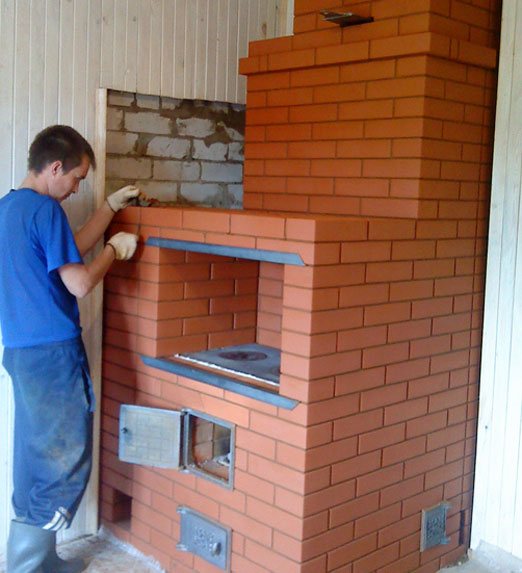
This movement of hot air is typical when the valve is closed. When the direct passage remains open, air masses rush into the upper chamber and are removed through the pipe.
The cooking oven uses the well-known law of convection: hot masses move freely through the chimney, despite the valves and channel walls.
The heat transfer of the heating device can be increased several times if a cast-iron stove is placed above the firebox. Its thickness affects the duration of the heat release period.
We put the bell oven
In double-bell furnaces, the heat load on the materials is extremely high. Therefore, it is easy to make a mistake and implement a similar structure with massive walls. The fire will burn in it, but instead of the expected heat, you will receive smoke and soot.
Analysis of the order of Kuznetsov furnaces for various purposes, which are based on a 2-kolpaktovy version, (heating and cooking, for a bath, with the installation of a double-circuit hot water boiler, etc.), allows us to identify a very characteristic feature. On a unit Nout, equal to 500 W / m2 of the outer surface of the material, almost 1.5 times less is consumed than in products of traditional designs.
This has both a plus (cheaper construction due to the need for fewer bricks and mortar for masonry) and a minus. Such products make high demands on the development and strict observance of all technological nuances of masonry.Since the actual heat load, which is safe for a thick-walled furnace, is capable of destroying the thin wall already at the stage of the accelerating furnace.
Construction mechanics should also be close and understandable to a stove-maker who decides to lay out a bell-type stove with his own hands. The simplest confirmation of this thesis is that the strength characteristics of the wall laid with the use of clay mortar, if its thickness decreases, fall much faster than that of cement masonry. This places high demands on the foundation of such a furnace. The stove operator is obliged to strictly follow the recommendations of the author of the order with which he works. Moreover, not only when arranging the foundation, but further, at all other stages of the laying of the furnace.
Their primary basis is a floating firebox. It is laid out from refractory bricks (fireclay). The most popular brands are Ш-5 and ШБ-8. The rest of the furnace body is made of ordinary ceramic bricks, grades from M150 and above.
Recall floating, it is called because:
A dry seam is formed around the firebox from all sides, or in places strictly established by the order.
The technique for its implementation is as follows. After completing the laying of the last row of fireclay bricks, the masonry mortar is removed from all the joints between it and the ceramic brick. In the resulting voids, special gaskets are inserted, which are prepared from various types of mineral cardboard. The most commonly used are kaolin and basalt. It is possible to use other technologies, which are necessarily specified in the specifications available for a specific furnace.
Disconnected modules. This principle is subject to strict observance. Fireclay bricks in any version should not be inserted into the grooves between ceramic bricks (the opposite is also true), even if there are damping joints.
The heat capacity of fireclay bricks and its TCR are significantly different from those of ordinary ceramic bricks. Therefore, the firebox, if there is a connection with the main body of the stove, will simply tear the masonry already at the stage of kindling.
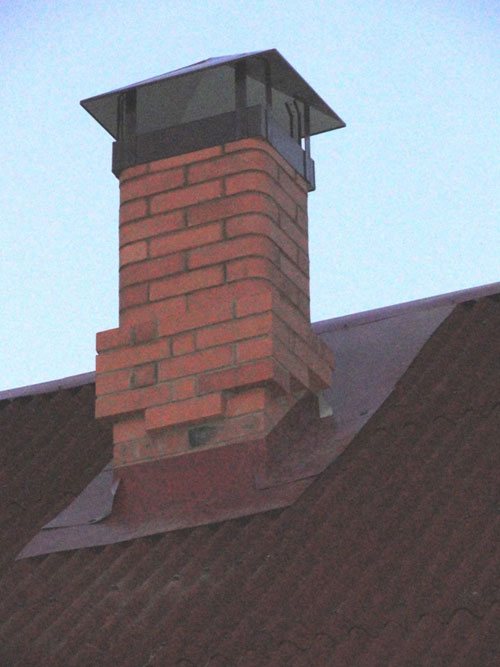

That is why it is required to make a firebox for such stoves as a fairly compact module inserted into a socket prepared from ceramic bricks. At the same time, there are a number of technical nuances of ensuring the removal of gases through the chimney.
It is very important to use in work only the material named in the specification for the furnace, as well as specified in the order. The designs of such furnaces are calculated and high-tech.
Therefore, replacement has a very negative effect on the performance of the finished product. In the best case, the oven will have to be repaired. At worst, disassemble completely and lay out in a new way.
Furnace types
There are several types of stoves for heating greenhouses, differing in the following parameters:
- The principle of heat radiation.
- The principle of heat propagation.
- Basic structural elements.
- Fuel combustion chamber type.
- Location and design of air supply channels.
- Convection shirts.
- Additional elements. As a rule, they have their own for each type of oven.
It is not difficult to make a furnace for a greenhouse with your own hands. At the same time, a long-burning sawdust stove will be able to effectively heat the air in a large greenhouse.
As fuel in greenhouse stoves, you can burn not only sawdust, but also the following types of fuel:
- Pellets.
- Peat granules.
- Ordinary firewood.
- Oil and other liquid fuels.
Heating a polycarbonate greenhouse with an infrared heater
It is worth notingthat the order of stoves for heating greenhouses of different sizes can vary significantly. Therefore, before starting work, it is recommended that you carefully familiarize yourself with the theoretical material.
Gallery: long-burning bell-type furnaces (25 photos)
Greenhouse bell furnace
If you need to quickly heat up the air in the room, then it is best to use a bell-type oven.It begins to give off heat intensively literally a few minutes after the start of warming up. At the same time, with its small dimensions, it is capable of heating a large room, as it provides prolonged fuel burning.
The bell system has one serious drawback - high heat losses. This heat loss does not depend on the type of fuel used.
Do-it-yourself bell-type sawdust stove is best made of metal. In this case, it will evenly heat the air in the room.
The main element of such a furnace is a metal body. Usually it is made from those materials that are at hand:
- Steel cylinder. It can be cooked by yourself.
- Empty gas bottle.
- Thick-walled metal pipe of large diameter.
- Metal barrel and water tank.
After selecting a suitable housing for the sawdust stove in the greenhouse, you need to purchase fittings and a strip of steel. Naturally, one must not forget about the chimney.
You can make do-it-yourself bell-type furnaces based on a barrel:
- You need to cut off the top of the barrel or the lid.
- Cut a groove in the resulting element and weld a piece of pipe into it. This will be the chimney.
- A door is cut through the wall of the barrel for storing the combustible material.
- The lid is processed in such a way as to pass freely into the barrel. It can then be compacted with a pre-prepared steel strip.
- At the final stage, another hole is cut in the lid, to which one pipe is welded to the food. This is blowing.
Installation of the necessary equipment for greenhouses and greenhouses
The principle of operation of such a furnace is very simple: the fuel inside it does not burn, but smolders. As the fuel burns out, the lid pushes the ash and smoothly drops down under its own weight.
The design of such a furnace can be complicated by adding a full-fledged ash pan and an independent firebox.
Advantages and disadvantages
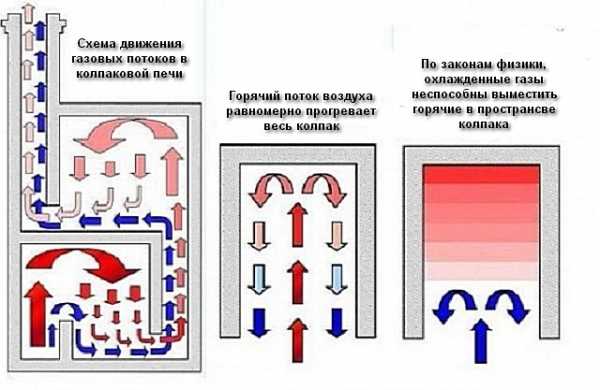

The principle of hot air movement in a bell-type furnace
Kuznetsov's designs have many advantages. One of them is the increased efficiency - 93 percent. For comparison - in Russian stoves it is about 80. At the same time, “blacksmiths” have uniform heat transfer, less temperature fluctuations.
Other design advantages:
- There is no soot left, and therefore the stove and the flue duct may not be cleaned for several years, which greatly simplifies maintenance.
- The device can be erected anywhere - in the corner zone, in the middle of the room, near the wall. Often, a two-bell oven heats several floors of a house on one tab.
- The stove chimney can be shortened to save bricks.
- "Kuznetsovka" is easily combined with a stove, fireplace, stove bench, differing in a variety of modifications.
- It is easy to connect a water circuit to the stove and pipe heated water for bathing or heating.
- Thanks to the increased level of pyrolysis, fuel is saved, which can be anything.
- The masonry will last longer, there is less risk of cracks.
- With the shutter open for a short time, it is almost impossible to cool the stove, because the cap is always filled with warm air, and the cold one is pressed downward.
Design features
There are no difficulties with the search for drawings of bell-type brick furnaces. There are at least 150 options in the public domain alone. But all of them, one way or another, were created according to the same technique, since only it allows you to combine productivity and heating system efficiency.
To make such a "blacksmithing" is not at all easy. It is necessary to observe the orders developed by Kuznetsov.
According to the standard scheme, the "blacksmithing" should have 2 caps: lower and upper. The lower hood is connected to the firebox, and the upper one is located in the upper part of the stove.
The lower hood is required to separate the gases into cold and hot streams.This allows you to get rid of the disadvantage inherent in channel brick analogs - heat loss under the action of draft through the chimney.
The hot gas in the "Kuznetsovka" lingers for a long time under the first bell. Then it goes into the second bell, since its base is located above the top of the first bell. Due to this, the hot gas gives off the bulk of its heat to the walls of the furnace. The efficiency of this design is 95%. This is almost twice as much as the efficiency of a traditional Russian brick oven.
Infrared heaters: description, principle of operation
In "blacksmiths" for heating the house, it is possible to control the flow of hot gas using valves. Depending on their position, the movement of gas through the air channels changes. So, when one of the valves is opened, hot air will go into the chimney, bypassing the upper bell. This is the so-called summer option.
